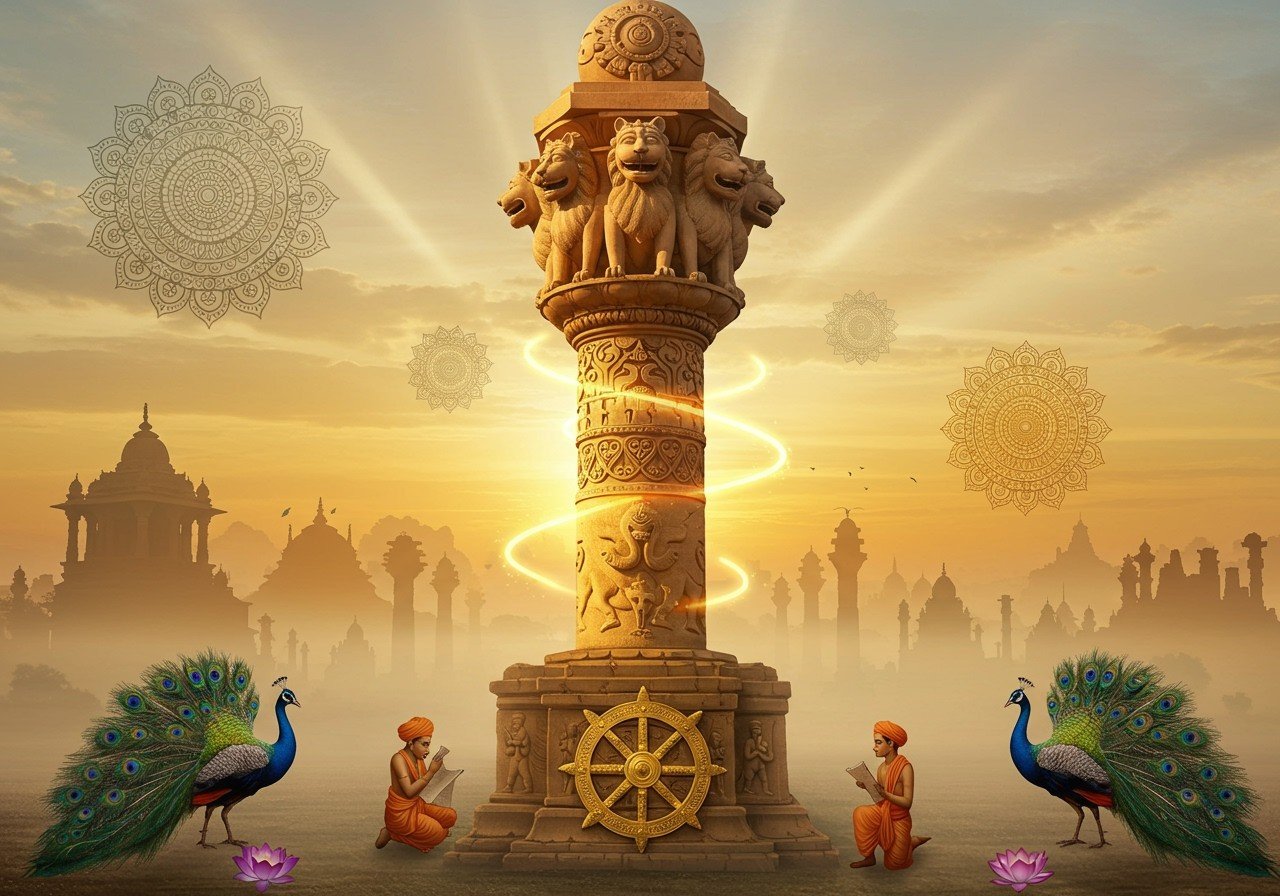
The Ashoka Pillars, magnificent monoliths erected by Emperor Ashoka the Great between 268 and 232 BC, stand as enduring symbols of Dhamma, the principles of righteous conduct central to Buddhism. Scattered across the Indian subcontinent, these pillars mark significant Buddhist locations, including the Buddha’s birthplace and key monasteries. They serve as a testament to Ashoka’s profound transformation after the Kalinga War, marking his embrace of Buddhism and his commitment to propagating its teachings of peace and non-violence. These pillars, often referred to as the “pillars of the Dharma,” embody Ashoka’s legacy and offer a glimpse into the rich history and cultural significance of the Mauryan Empire.
Historical Context of the Ashoka Pillars
Emperor Ashoka, initially known for his military prowess, experienced a profound shift in perspective following the devastating Kalinga War. The suffering he witnessed led him to adopt Buddhism, embracing its tenets of non-violence, compassion, and moral governance. As a means of disseminating these principles throughout his vast empire, Ashoka commissioned the construction of these pillars. Each pillar served as a public proclamation of his commitment to Dhamma, a tangible representation of his reformed ideology.
The construction of these pillars involved remarkable architectural skill and artistry. Skilled artisans, including those influenced by Greek and Persian traditions, contributed to their creation. The pillars, often crafted from polished sandstone, showcase intricate carvings and inscriptions, reflecting the advanced craftsmanship of the era.
Geographic Distribution of Ashoka Pillars
Strategically placed across the Indian subcontinent, Ashoka Pillars can be found at locations of significant Buddhist importance:
- Sarnath: This sacred site marks the location where the Buddha delivered his first sermon after attaining enlightenment, setting in motion the wheel of Dharma. It is here that the iconic Lion Capital, now India’s national emblem, originally crowned an Ashoka Pillar. Explore more about sacred sites.
- Vaishali: Known for its association with the Buddha’s teachings and the development of early Buddhist monasticism, Vaishali held a special place in Buddhist history. The presence of an Ashoka Pillar here underscores its importance as a center of Buddhist learning and practice.
- Lauriya Nandangarh: This site is renowned for its remarkably well-preserved Ashoka Pillar, complete with inscriptions that provide invaluable insights into Ashoka’s reign and the principles of Dhamma. The pillar stands as a testament to the enduring legacy of the Mauryan emperor.
These locations were carefully chosen to maximize the reach of Ashoka’s message, ensuring that his edicts reached a wide audience. The Archaeological Survey of India (ASI) plays a crucial role in preserving these historical sites, protecting them for future generations.
Enduring Significance of Ashoka Pillars
The Ashoka Pillars hold immense symbolic and cultural importance, representing not only the spread of Buddhism but also Ashoka’s vision of a just and compassionate society. The inscriptions, or edicts, carved into the pillars, serve as moral and ethical guidelines based on Buddhist principles.
The pillars served as a powerful communication tool, broadcasting Ashoka’s vision across his empire. Their influence extends to contemporary Indian culture, where they continue to be revered as symbols of peace, tolerance, and righteous governance. Explore more on rituals and practices.
Distinctive Architectural Features
The architecture of the Ashoka Pillars is unique and impressive, displaying a blend of influences:
- Shaft: Typically tall and cylindrical, the shaft is often made of polished sandstone, giving it a smooth and imposing appearance. Its height served to make the pillar visible from a distance, amplifying its message.
- Capital: The top portion, or capital, often features intricately carved animal figures, such as lions, bulls, and elephants. These figures hold symbolic meaning within Buddhist and Indian traditions.
- Crowning Figures: The capitals are often surmounted by artistic representations, showcasing a fusion of Persian, Greek, and Indian artistic styles. These crowning figures add to the aesthetic and symbolic richness of the pillars.
The precise measurements and proportions of the pillars demonstrate a high level of architectural sophistication and craftsmanship. Explore sculptures and idols.
Inscriptions and Edicts: Voices from the Past
The inscriptions on the Ashoka Pillars, primarily written in Prakrit using the Brahmi script, include both Major and Minor Rock Edicts. These edicts cover a wide range of topics, from moral precepts and administrative instructions to messages promoting non-violence, compassion, and religious tolerance. They offer a window into Ashoka’s thinking and his efforts to establish a just and harmonious society. Explore Pooja essentials.
Preservation and Restoration: Safeguarding a Legacy
The preservation of these ancient monuments is vital for maintaining India’s rich cultural heritage. The Archaeological Survey of India (ASI) plays a critical role in conserving the Ashoka Pillars, undertaking restoration projects to ensure their structural integrity and protect the inscriptions from environmental damage. Visiting these historical sites offers a tangible connection to India’s past, while also supporting ongoing preservation efforts.
Poojn.in: Connecting You with India’s Spiritual Heritage
Poojn.in, India’s leading online store for cultural and religious goods, offers a wide selection of products to enhance your understanding and appreciation of India’s rich spiritual traditions. Explore our collection of books, artifacts, and ritual items related to Buddhism and the Mauryan era. Discover spiritual products here.
Conclusion
The Ashoka Pillars remain powerful symbols of Dhamma, representing Emperor Ashoka’s vision of a society grounded in peace, non-violence, and moral principles. These magnificent structures offer invaluable insights into the history, culture, and religious landscape of ancient India. By learning about their significance and supporting their preservation, we honor a remarkable legacy and ensure that future generations can continue to be inspired by these enduring pillars of wisdom.


